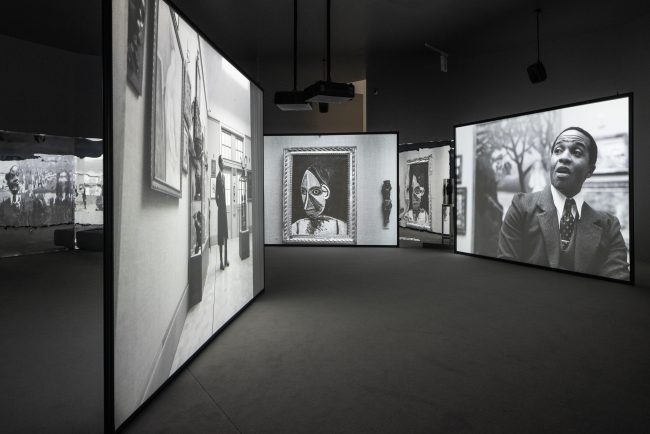
27 September 2024 – 16 February 2025
Review by Anthony Frater (Arts Wednesday)
When is film art or when is art film? Well it’s been a long time since art exclusively meant painting or drawing, nowadays everyone is an artist and everything is art, whether it be dance, film or music, or opera, theatre and literature.
Nonetheless, on now at the MCA we get to see the work of one of the world’s great contemporary artists. Filmmaker, installation artist, tutor, mentor and teacher, awarded a Knighthood in 2022 for services to the arts, at just 64 years old there isn’t much Sir Isaac Julien CBE RA (1960 – present) has not achieved in a career in art and film that spans more than 40 years.
Born in London of Caribbean parents, he graduated in 1985 from Saint Martin’s School of Art where he studied painting and fine art film. Much of his work draws upon many different art forms to create visually compelling, narrative driven multi screen film installations. He is in many ways a powerful voice for the black and/or gay lived experience, tackling everything from sexual identity and class, to challenging us with philosophical questions around artistic and cultural heritage.
Early career successes cemented Isaac’s reputation. His iconic 1989 drama documentary Looking for Langston, brought him fame especially in the world of film. Just 2 years later in 1991 he won the Semaine de la Critique prize for best film at the Cannes Film Festival with a work entitled Young Soul Rebels.

In this latest work, Once Again… (Statues Never Die), he revisits some familiar themes. It’s a sensual, silver laden monochromatic, high definition, beautifully filmed work that projects its images, the action so to speak, onto 5 large double sided screens. To add to this every wall around the edge of the room has a reflective mirrored like surface that actually deliberately distorts the reflected image. Then there is the sound: a somewhat overly reverbed spoken voice and an ever-present electronic hum waxing and waning away underneath – threatening, highlighting, dramatising, warming, comforting.
So why 5 screens? Normally our minds are capable of dealing with several different thoughts as we listen or watch or interpret what is being said or acted out – many split second reels of conscious thought. It is arguably easier to reproduce this natural way of thinking, this cerebral dynamic, using 5 screens as opposed to just one: the spoken narrative interplays with the visual narrative all at once across the different screens.
You only have to focus on one screen to get the full 32 minute story. Playing with ideas around perspective – the secrets and the value inherent in looking or thinking of things from different perspectives – the other screens magically (not really it’s just art, extremely clever fine art that’s all) support or add weight to whatever is happening on the screen that is your focus. For example the viewer is able to simultaneously view the same image from different angles: so someone walking up a set of stairs will be seen from behind on one screen, from in front on another, and from above on yet another, all relevant to the narrative and the screen that you focus on.
As you listen to the dialogue and he argues his theories, the viewer feels like they get a peak into his imagination, his feelings or passions via the other screens – like an expressionist painting, visual tropes or even colour correspond to feelings and mood.

Julien is also playing with time. Real life time is not linear, it does not necessarily move in one direction, theoretically it might but in reality it shifts, moves back and forward, past present and future, our minds can easily take us there, as does here the narrative and the dialogue. Conversely, timelessness, or even the here and now, is arguably achieved through the accompanying sound track: an electronic sound bath washing over us underneath the spoken word, let’s say like a primordial hum, timeless and eternal but paradoxically also very present in the here and now because in reality, it is.
And so to the narrative and the dialogue. It helps to know who the characters in this non fictional story are: played by actors, Dr. Albert C. Barnes, was an American visual art collector and exhibitor of, not exclusively, African material culture. His protagonist is famed philosopher and cultural critic Alain Locke, known as the Father of the Harlem Renaissance: an intellectual and cultural (and no doubt spiritual) revival of African-American culture, politics and scholarship (music, dance, art, film, fashion, literature theatre, politics and scholarship) centred in Harlem, Manhattan, New York in the 1920s and 1930s. Julien had access to the Archives of the Barnes Foundation where much of his research for this work was carried out.

The work tackles some hot topics current in the art world now. Among them: how art has been collected and who are the rightful owners; responsible curatorship; exploitation of art rather than protecting it and understanding it; the legality of provenance, who owns it, and how we label it. It’s also about technological advances in the production of art, how colour pigments transformed western art. The Impressionists could paint en plain air because colour pigments at the time were finally produced in tubes making them easy to transport. These technological advances falsely though compellingly elevated western art to exclusiveness and albeit wrongly, relegated other forms of art from ‘elsewhere’ to just so-called “primitive art”.
Finally but by no means exhausting what we might get from the work, and that is returning art to where it was produced particularly if it has come to light in the present time that the work(s) were acquired illegally. The most prominent example of this today, almost a test case, is the decades long campaign to have the Parthenon Marbles returned to Athens, Greece. The worst arrogance of course is the fact that the new owner of these priceless objects (in this case the British Museum) acquired the Marbles by spurious, even illegal means and will then go on to claim that the work was and will always be better off where it is now, it will be seen by more people they will say, it will be better looked after and preserved they will say – nothing of course could be further from the truth.
It’s a must see exhibition, settle in with the work and watch it through – there are seats – then go and grab a coffee, then come back again and let it wash over you once again.
Share "Review: Sir Isaac Julien. Once Again… (Statues Never Die) "
Copy










